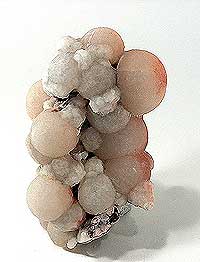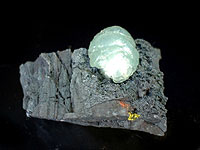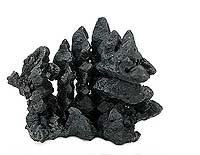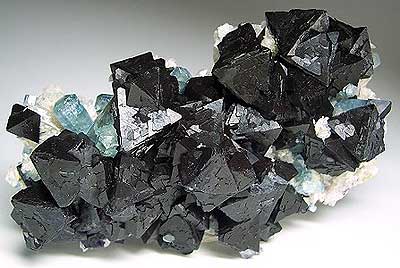Archived Article Detail
By Thomas P. Moore
Need to search for a keyword, title or article on this page? On your keyboard, hold down the “Ctrl” and “F” key and a “Find in page” box will appear at the bottom of your screen. Type in your keyword and check the “Highlight All” box and like magic your keyword will appear highlighted as you scroll up and down the page!
WHAT’S NEW IN THE MINERAL WORLD ARCHIVE – posted on 10/10/2005
There don’t happen to be a lot of truly new items on the cyber-market right now, but here are a few colorful (mineralogical) leaves for autumn, anyway…
Miscellaneous World Occurrences

Rob Lavinsky’s Arkenstone website (www.irocks.com) can generally be counted on to show off interesting new finds which come Rob’s way. One of the site’s standouts this past summer was an offering of about a dozen superb miniature and small cabinet-size specimens from a new strike of morganite beryl at an old and famous locality: the Elizabeth R mine, Pala district, San Diego County, California. Consult Jesse Fisher’s article “Gem and rare-element pegmatites of southern California” in the Sept.-Oct. 2002 issue, and you will learn that a claim on this pegmatite dike was staked in 1903, but that significant specimens were not collected, as far as is known, until Roland Reed found gemmy morganite crystals to 13 cm there during the 1970’s; another big strike occurred in 1992. In 2000 an entirely new adit was begun at the Elizabeth R, and presumably it was in this working that a large pocket yielded about 100 fine new morganite specimens in late January and early February 2005, while the Tucson show was in progress. Rob Lavinsky got a handful of the larger specimens from this strike, with tabular morganite crystals to 8 cm across. The single crystals and parallel crystal clusters are to be recommended for their very sharp form, high luster, good pink color, and at least partial gemminess (see photo).
Another big scoop presented recently on the Arkenstone website concerns gemmy crystals of painite which were found in 2004-2005 in the gemstone-mining tracts around Mogok, Myanmar (Burma).  Painite is CaZrBAl9018; the species occurs as gemmy orange-red to brownish red, simple hexagonal prisms associated with spinel and ruby corundum in gemstone-bearing alluvium. The type locality is a site near the village of Ohngaing, where exactly two tiny crystals were found in the early 1950’s. The new crystals reportedly come not only from Ohngaing but also from several new localities, also in Myanmar (see http://minerals.gps.caltech.edu). The gemmiest painite crystals seldom exceed 1 cm along the c axis, but Rob’s site also offers cruder crystals to more than 3 cm, most of them lightly encrusted by tiny red subhedral corundum crystals. Not surprisingly (since Bill Larson travels regularly to Burma), the Pala Properties International dealership likewise has some specimens: about 15 loose painite crystals, reddish brown and sharply formed and part-gemmy, to about 2.5 cm were on hand at the Denver show (inquire at www.palagems.com). The painite “mine” near Ohngaing is now sparsely turning out matrix specimens too, so that we won’t have to deal in these cases with alluvial rounding of crystal edges.
Painite is CaZrBAl9018; the species occurs as gemmy orange-red to brownish red, simple hexagonal prisms associated with spinel and ruby corundum in gemstone-bearing alluvium. The type locality is a site near the village of Ohngaing, where exactly two tiny crystals were found in the early 1950’s. The new crystals reportedly come not only from Ohngaing but also from several new localities, also in Myanmar (see http://minerals.gps.caltech.edu). The gemmiest painite crystals seldom exceed 1 cm along the c axis, but Rob’s site also offers cruder crystals to more than 3 cm, most of them lightly encrusted by tiny red subhedral corundum crystals. Not surprisingly (since Bill Larson travels regularly to Burma), the Pala Properties International dealership likewise has some specimens: about 15 loose painite crystals, reddish brown and sharply formed and part-gemmy, to about 2.5 cm were on hand at the Denver show (inquire at www.palagems.com). The painite “mine” near Ohngaing is now sparsely turning out matrix specimens too, so that we won’t have to deal in these cases with alluvial rounding of crystal edges.
In early September a well-digging in India produced a significant mineral find—as well-diggings in India often have done—and a handful of striking-looking miniature to large-cabinet specimens for Rob Lavinsky to add to his site. Three Indian dealers also bought up some of these intriguing specimens of thomsonite, a zeolite species heretofore almost unknown from the basalts of the Deccan Plateau (in the Indian Zeolites Special Issue, Berthold Ottens writes that thomsonite “is one of the rarest zeolites of the region…not to be found among dealers’ offerings”).  This newly found thomsonite occurs as perfect spheres, to 7 cm in diameter, composed of radiating acicular crystals, resting directly on brownish gray basalt matrix. The spheres are opaque and creamy white to very pale orange, with the surface texture of fine-grained sandpaper. Specimens consist of isolated spheres or intergrown, wavy-surfaced groups of spheres resting lightly on matrix, or grapelike clusters free of matrix (as in the photo here). This material was originally called pectolite, mesolite, scolecite, or a mixture of these (since indeed you would think of any of them before you would think of thomsonite), but testing has settled the question: it is in fact thomsonite. The well-digging site from which the specimens came—and more perhaps will come—is said to lie in a forest near Aurangabad, Maharashtra.
This newly found thomsonite occurs as perfect spheres, to 7 cm in diameter, composed of radiating acicular crystals, resting directly on brownish gray basalt matrix. The spheres are opaque and creamy white to very pale orange, with the surface texture of fine-grained sandpaper. Specimens consist of isolated spheres or intergrown, wavy-surfaced groups of spheres resting lightly on matrix, or grapelike clusters free of matrix (as in the photo here). This material was originally called pectolite, mesolite, scolecite, or a mixture of these (since indeed you would think of any of them before you would think of thomsonite), but testing has settled the question: it is in fact thomsonite. The well-digging site from which the specimens came—and more perhaps will come—is said to lie in a forest near Aurangabad, Maharashtra.
 Rocko Rosenblatt from New York (one of my favorite mineral amigos, always up for sharing a morning coffee at the Denver show) was first to put me on to some superb new specimens of South African brucite, although, alas, he hasn’t been able to show me more than a single thumbnail, as a batch of specimens which he got from Gerdus Brönn sold out almost instantly. On to the relevent website, then (www.bronnrocks.com), and to an e-mail exchange with Gerdus (gerdus@mineralgallery.co.za), from whom I learned that the brucite specimens came from a new shaft called the N’Chwaning III, in the famous Kalahari Manganese Field near Kuruman. The first indications were some yellow druses of sturmanite on black manganese oxide ore, with sturmanite crystals to 3 mm; it was in March through June of this year that the miners started taking out beautiful sturmanite/brucite combination specimens. The brucite comes as lustrous baby-blue spheres with botryoidal surfaces, some with a beautiful golden sheen, with small yellow sturmanite crystals around their bases. Most of the brucite aggregates, to 4.5 cm in diameter, were collected off matrix, making for very striking thumbnails and miniatures; the specimen pictured here, though, shows a brucite sphere perched well on black hausmannite (?). According to Gerdus “the find is finished”—although I’ll note that manganese mining around Kuruman goes on, so that future finds must be regarded as possible. The present specimens look nothing whatever like the pearly white to pale green rosettes and spherical clusters of platy brucite crystals found once-upon-a-long-time-ago at the Woods Chrome mine, Lancaster County, Pennsylvania.
Rocko Rosenblatt from New York (one of my favorite mineral amigos, always up for sharing a morning coffee at the Denver show) was first to put me on to some superb new specimens of South African brucite, although, alas, he hasn’t been able to show me more than a single thumbnail, as a batch of specimens which he got from Gerdus Brönn sold out almost instantly. On to the relevent website, then (www.bronnrocks.com), and to an e-mail exchange with Gerdus (gerdus@mineralgallery.co.za), from whom I learned that the brucite specimens came from a new shaft called the N’Chwaning III, in the famous Kalahari Manganese Field near Kuruman. The first indications were some yellow druses of sturmanite on black manganese oxide ore, with sturmanite crystals to 3 mm; it was in March through June of this year that the miners started taking out beautiful sturmanite/brucite combination specimens. The brucite comes as lustrous baby-blue spheres with botryoidal surfaces, some with a beautiful golden sheen, with small yellow sturmanite crystals around their bases. Most of the brucite aggregates, to 4.5 cm in diameter, were collected off matrix, making for very striking thumbnails and miniatures; the specimen pictured here, though, shows a brucite sphere perched well on black hausmannite (?). According to Gerdus “the find is finished”—although I’ll note that manganese mining around Kuruman goes on, so that future finds must be regarded as possible. The present specimens look nothing whatever like the pearly white to pale green rosettes and spherical clusters of platy brucite crystals found once-upon-a-long-time-ago at the Woods Chrome mine, Lancaster County, Pennsylvania.
Dr. Jorge Dascal of Argentina (patagoniaminerals@hotmail.com) has recently been looking into secondary sulfate mineralization at the old Santa Elena mine, La Alcaparrosa, San Juan Province, Argentina—a locality visited during the 1940’s by the famous mineralogist Samuel Gordon but largely forgotten since then (see Alfredo Petrov’s short article in the September 2005 issue of Mineral News). Among the exotic sulfates from this mine are butlerite, parabutlerite, slavikite, fibroferrite, sarmientite, and botryogen; what are probably the world’s best crystals of the last-named have been collected from dump material at the Santa Elena mine by Jorge Dascal and others. Embedded in colorful masses of mixtures of the other rare species, botryogen forms bright orange crystals to 2.5 cm, and these form radial sprays to 5 cm. Early batches of specimens showing mostly subhedral botryogen crystals have appeared at a few fall-season shows, and word is that more and better specimens wait somewhere further back in the supply pipeline…this is something to watch for in Tucson.
Scott Werschky has posted on the site of his Miner’s Lunchbox dealership (www.minerslunchbox.com) some spiffy-looking specimens from a new Namibian strike of “demantoid” (i.e. gemmy green andradite) garnet. Sharp, lustrous, gemmy or part-gemmy dodecahedral “demantoid” crystals to around 1 cm are embedded in massive matrix of mottled brown-white calcite, a few specimens also showing tiny quartz crystals in micro-pockets. The garnet crystals have an oily green color which approximates (in the web photos anyway) “peridot green”; in typical matrix specimens, anywhere from one to five such crystals are seen about half-embedded in the calcite. The locality given is the Tubussis Farm, Usakos, Erongo Flats, Karibib, Namibia.
Much That’s New From Morocco
I’d call it a “smorgasbord” if it weren’t for the inappropriate cultural (Swedish) connotations, nor does “shishkabob” come close to working…so I’ll just get out of the kitchen and simply, literally observe that many new mineral discoveries have been coming to light in Morocco lately. Not all of them, of course, are of a blockbuster nature, and not all involve specimens which can be called beautiful, but all are interesting, and most are fraught with high promise. Most emerging Moroccan material stops first in western Europe—the Ste.-Marie-aux-Mines show is an established venue for Moroccan debuts—and so it is not surprising that the website of Jordi Fabre of Barcelona (www.fabreminerals.com) is especially rich, these days, in new finds from Morocco. The survey below comes mostly from Jordi’s site, although many of the same items are now being offered by other dealers as well (honorable mention here goes to longtime Morocco-minerals specialist Horst Burkard, Dornheckenstr. 20, 53227 Bonn, Germany).
Calcite is being found at the AGM mine, Akka, Tafraout, Morocco, as very attractive specimens showing lustrous, transparent-colorless, flattened rhombohedral crystals in hemispherical aggregates to 3 cm; the curved stacks of calcite crystals perch on clusters of sharp, dark brown rhombohedral crystals of siderite. Jordi Fabre offers three good miniatures on his site.
El Hamman (or Hammam), near Meknes, in Morocco’s dead desert center, has for several decades now produced good fluorite specimens, and continues intermittently to do so: Jordi has some beautiful cabinet-size clusters with intense green, transparent, cubic fluorite crystals to 3.3 cm on edge, some of the crystal faces being coated by druses of pyrite microcrystals. And recently some dealers, most notably Horst Burkard, have been offering good fluorite specimens from a new working near Taourirt, the fluorite crystals in this case being pale to deep purple, transparent, simple cubes to 2 or 3 cm on edge.
Occasionally noted, but never famous, for scorodite specimens, the Ahrbar mine, Bou Azzer, is the source of a 2.5 x 5.5 x 6.3-cm matrix specimen with an open seam lined by very sharp scorodite crystals to 6 mm—this one reposing in Jordi Fabre’s “Morocco room.”
A skarn deposit at Imilchil, in the Anti-Atlas Mountains, has lately been turning out fine specimens both of titanite and epidote. The titanite comes as sharp, part-gemmy, yellow-green bladed crystals to 1.5 cm in clusters with drusy albite; unlike the titanite crystals from Alpine-type pockets in Switzerland and Pakistan, these titanite crystals are not fishtail twins but rather untwinned individuals. The epidote of Imilchil occurs as highly lustrous, sheaf-shaped and bowtie-shaped aggregates of yellow-green crystals which in some cases cover wide matrix expanses.
 Jordi offers a few beautiful, mostly miniature-size specimens of azurite from a February 2005 discovery at what seems to be a new Moroccan locality: the Oumjrane mine, Alnif. Azurite crystals between 6 mm and 1.2 cm are densely clustered on earthy pale green malachite which forms mammillary linings of pockets in matrix. The azurite crystals are highly lustrous, azure-blue, and of an odd habit: lacking prism faces, they resemble octahedrons or dipyramids.
Jordi offers a few beautiful, mostly miniature-size specimens of azurite from a February 2005 discovery at what seems to be a new Moroccan locality: the Oumjrane mine, Alnif. Azurite crystals between 6 mm and 1.2 cm are densely clustered on earthy pale green malachite which forms mammillary linings of pockets in matrix. The azurite crystals are highly lustrous, azure-blue, and of an odd habit: lacking prism faces, they resemble octahedrons or dipyramids.
An earlier-known Moroccan locality for azurite is Kerrouchen, Khenifra: very little azurite from this place has been seen in the past couple of decades, but late in 2004 there was a discovery of a few very nice miniature, toenail and thumbnail-size specimens. Thin-prismatic azurite crystals grow in very tight parallel groups which are in effect compound, bladed crystals to 5 cm, these terminated on both ends by little stick-forests of individual crystal tips. Other Kerrouchen specimens offered by Jordi are clusters of sharp, single, lustrous azurite crystals to 3 cm, and one is a single, super-sharp, equant crystal measuring 1.9 x 2 x 2.2 cm on a shard of pale brown matrix.
In 2002, a new strike of chalcostibite at its earlier-known locality, Rar el Anz near Casablanca, produced better specimens of this rare sulfosalt than before, with moderately sharp, blocky crystals to 2 cm, inwardly metallic black but rendered bright earthy blue by their uniform coatings of (and partial pseudomorphing to) azurite. In 2003, some colorful specimens of linarite and brochantite were unearthed at Goulmina, Er Rachidia; these show bright blue linarite as bladed crystals to 1 cm, and bright green acicular brochantite crystals, both lying flat against white quartz. Jordi still has good specimens representing both of these offbeat Moroccan occurrences.
The great Touissit mine is now closed and on maintenance status only, and so it seems that its world-class anglesite, cerussite and azurite specimens are things of the past—although Jordi did have a few first-rate Touissit azurites. Vanadinite from the Mibladen area continues to be almost embarrassingly abundant, as any contemporary showgoer on any continent can testify. Skutterudite from Bou Azzer is no longer as rare as it once was on the market; there have been, however, no fresh strikes of erythrite to bolster supplies garnered in the great days of 2000 (see my Denver report in Jan.-Feb. 2001). But then, some very good specimens of roselite and beta-roselite were found in the Ahrbar mine, Bou Azzer, in 2004: these show lush-looking open pockets and seams in the familiar white calcite matrix, the open places aglow with the purple-red of hundreds of roselite and beta-roselite crystals, with some individuals reaching 3 mm.
The new Moroccan mineral discovery which is now in a general way “the talk of the town” is acanthite from the Imiter silver mine, Ouarzazate province, central Morocco. Both Bill Larson and I reported on some very small lots of inferior specimens (as we can now safely call them) which made it to the Ste.-Marie and Munich shows in 2004, and since then specimen lots have appeared with Dave Bunk, Jordi Fabre, Horst Burkard, Rob Lavinsky, Doug Wallace and probably some others. The word is that several hundred acanthite specimens were found in the Imiter mine between January and June 2005, and the hoard was held back in Europe until, at Denver, it burst onto the scene via several major dealers—these included dealers mentioned above, but the best selection of all was with Brad and Star van Scriver of Heliodor, who had about a hundred Imiter mine acanthites in sizes from small-thumbnail to medium-cabinet. One’s aesthetic sense got a fun workout when one sought to choose which specimen in one’s preferred size (thumbnail in my case) to go home with. Collectors with limited tolerances for metallic gray minerals tended to be unimpressed with these new acanthites, which in most cases, yes, are literally lackluster, although some of them do have a pleasant gray sheen, and a very few of the smallest thumbnails are lustrous enough. What the specimens do have going for them is that the octahedral acanthite crystals reach more than 3 cm on edge and are uniformly sharp, and the clusters are “open” and crisp. Other specimen styles include single, isolated octahedrons with slightly bulging faces and wavy edges; toothy rows of between two and five such crystals all pointing “up”; and smaller crystals in nervous-looking dendritic formations.  My guess is that Imiter mine acanthite will be available on the market for some time to come: for one thing, the mine seems to be getting serious about turning out really good minerals, as witness the handful of wonderful wire silvers, and a few pretty clusters of small but brilliant red proustite crystals, which have turned up at the last several shows.
My guess is that Imiter mine acanthite will be available on the market for some time to come: for one thing, the mine seems to be getting serious about turning out really good minerals, as witness the handful of wonderful wire silvers, and a few pretty clusters of small but brilliant red proustite crystals, which have turned up at the last several shows.
A Finale From Kazakhstan
By now it is well known that show manager extraordinaire Marty Zinn has decided to sell his “old” collection (less well known, but no secret: he’s building a new one), and that diverse parts of the collection are now coming onto the market via diverse dealers. One of these dealers is John Veevaert, in whose large, labyrinthine, excellent website (www.trinityminerals.com), the “Asia room” has lately held ten cabinet-size specimens out of Marty’s collection, all of them gorgeous, all of them representing the too-brief appearance in the Western world of “combination” specimens of fluorite/fluorapatite/bertrandite from the Akchatau mine, Karaganda Oblast, Kazakhstan. Perhaps a couple of hundred of these specimens were found in the mid-1990’s, but by the year 2000 the Akchatau tungsten mine lay abandoned.
The fluorite crystals, to several cm on edge, are compound octahedrons with slightly concave, intricately stepped and scalloped faces; they are lustrous and transparent but so dark purple as to look black at first glance. The fluorapatite crystals are transparent, blue-green, simple hexagonal prisms to 1 cm; the tiny bertrandite crystals are white and bright. Of the ten former Marty Zinn pieces on John Veevaert’s site, the smallest measures 7 cm in maximum dimension, the largest 20 cm. All but one of the prices asked were four-figure and some were on the high side of that range, but never mind—all ten specimens are now sold. I offer a picture of one of them here mainly just to spread beauty around, and I offer news of them as a “finale” by way of recording what I think is a very impressive mineral occurrence, too little known in its time, which is now no more. 
A Museum Opening
On the evening of September 14, more than a hundred members of the worldwide mineralogical community came over from the Denver show to visit the Colorado School of Mines campus in Golden, there to attend a ceremonial open house marking the debut of the new, greatly expanded display facility for the School of Mines’ excellent mineral collection. The new hall is grandly modernistic, with a very high ceiling (as if one had entered the nave of a sort of cathedral of mineralogy), with several styles of display cases along the walls and scattered about the floor space. That abundant space not only provided plenty of room for roaming and schmoozing during the evening, but also gave promise of ample room for new display cases as the collection expands.
In the opening hour or so of the evening, while a silent auction fund-raiser for the museum proceeded in an adjoining room, the open bar hummed, several tablesfull of hors d’oeuvres were ravished, and a live string ensemble played Mozart while the throng of mineral people gazed raptly at the exhibits. Curator Paul Bartos circulated sociably among the attendees, obviously proud of the beautiful facility under his charge, which is the first new mineral museum to be built in the United States in many decades. The exhibits, of course, emphasize minerals from Colorado, loosely organized as to mining districts; there are also generous arrays of historical photos, documents and mining artifacts, and an intricate, four-foot-long model of an antique Colorado stamp mill in old brown wood. Beyond Coloradoiana, the depth and quality of the School’s collection is communicated by cases devoted to minerals from the western U.S., the eastern and central U.S., Mexico, South America, and “Worldwide Classics.” Two huge wall cases in the main hall display very showy and very large specimens donated by prominent Colorado collector Bruce Oreck. Looking around in this chamber could leave no question of the importance, sophistication and vitality of the Colorado School of Mines collection.
At one point, everyone gathered around to hear a brief dedicatory speech by Marty Zinn, a major donor and motive force behind the making of this beautiful display facility; and then Marty cut the ribbon before the door of a “special exhibits” alcove named for his late mother Betty Llewellyn. For the rest of the evening this narrow alcove was fairly jammed with gawkers, for the cases along its walls held many exceptional pieces on loan from Bryan Lees and Dave Bunk. Thus there was wondrous Sweet Home mine rhodochrosite and “Tree Root Pocket” microcline/smoky quartz to admire, and there were many superstar pieces from Dave’s famous Colorado collection—and as a thumbnailer I wouldn’t be worth my hot glue if I neglected to mention the transcendently exquisite, 2.5-cm cluster of enargite crystals from Colorado’s Longfellow mine which Dave had put in (which happens also to be Wendell Wilson’s favorite specimen in Dave’s collection).
From spicy-meatball hors d’oervres, to the strings’ Eine Kleine Nachtmusik, to the camaraderie everywhere, and yes even to that enargite specimen, it was a splendid inaugural evening. And though the music has died, the minerals (most of them anyway) are still there: go and see this great collection in its new home when you get the chance.
For questions about this column, please email Tom Moore.
